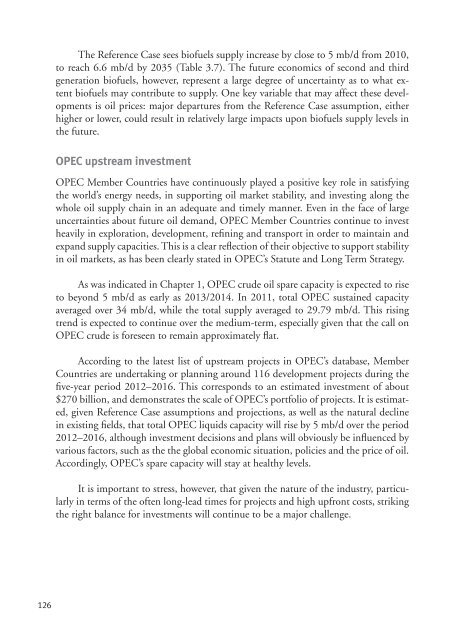World Oil Outlook - Opec
World Oil Outlook - Opec
World Oil Outlook - Opec
- TAGS
- world
- outlook
- opec
- www.opec.org
You also want an ePaper? Increase the reach of your titles
YUMPU automatically turns print PDFs into web optimized ePapers that Google loves.
126<br />
The Reference Case sees biofuels supply increase by close to 5 mb/d from 2010,<br />
to reach 6.6 mb/d by 2035 (Table 3.7). The future economics of second and third<br />
generation biofuels, however, represent a large degree of uncertainty as to what extent<br />
biofuels may contribute to supply. One key variable that may affect these developments<br />
is oil prices: major departures from the Reference Case assumption, either<br />
higher or lower, could result in relatively large impacts upon biofuels supply levels in<br />
the future.<br />
OPEC upstream investment<br />
OPEC Member Countries have continuously played a positive key role in satisfying<br />
the world’s energy needs, in supporting oil market stability, and investing along the<br />
whole oil supply chain in an adequate and timely manner. Even in the face of large<br />
uncertainties about future oil demand, OPEC Member Countries continue to invest<br />
heavily in exploration, development, refining and transport in order to maintain and<br />
expand supply capacities. This is a clear reflection of their objective to support stability<br />
in oil markets, as has been clearly stated in OPEC’s Statute and Long Term Strategy.<br />
As was indicated in Chapter 1, OPEC crude oil spare capacity is expected to rise<br />
to beyond 5 mb/d as early as 2013/2014. In 2011, total OPEC sustained capacity<br />
averaged over 34 mb/d, while the total supply averaged to 29.79 mb/d. This rising<br />
trend is expected to continue over the medium-term, especially given that the call on<br />
OPEC crude is foreseen to remain approximately flat.<br />
According to the latest list of upstream projects in OPEC’s database, Member<br />
Countries are undertaking or planning around 116 development projects during the<br />
five-year period 2012–2016. This corresponds to an estimated investment of about<br />
$270 billion, and demonstrates the scale of OPEC’s portfolio of projects. It is estimated,<br />
given Reference Case assumptions and projections, as well as the natural decline<br />
in existing fields, that total OPEC liquids capacity will rise by 5 mb/d over the period<br />
2012–2016, although investment decisions and plans will obviously be influenced by<br />
various factors, such as the the global economic situation, policies and the price of oil.<br />
Accordingly, OPEC’s spare capacity will stay at healthy levels.<br />
It is important to stress, however, that given the nature of the industry, particularly<br />
in terms of the often long-lead times for projects and high upfront costs, striking<br />
the right balance for investments will continue to be a major challenge.
















